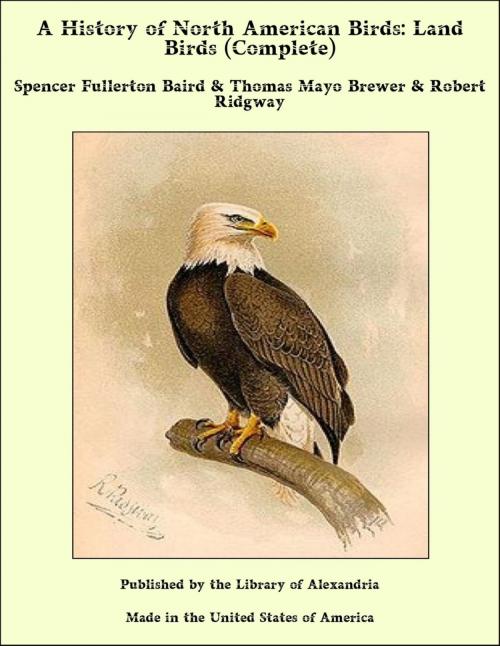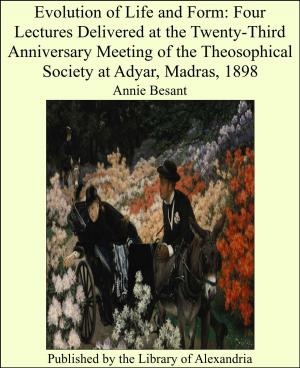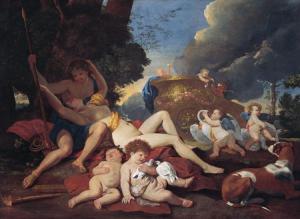A History of North American Birds: Land Birds (Complete)
Nonfiction, Religion & Spirituality, New Age, History, Fiction & Literature| Author: | Spencer Fullerton Baird & Thomas Mayo Brewer & Robert Ridgway | ISBN: | 9781465619303 |
| Publisher: | Library of Alexandria | Publication: | March 8, 2015 |
| Imprint: | Language: | English |
| Author: | Spencer Fullerton Baird & Thomas Mayo Brewer & Robert Ridgway |
| ISBN: | 9781465619303 |
| Publisher: | Library of Alexandria |
| Publication: | March 8, 2015 |
| Imprint: | |
| Language: | English |
The class of Birds (Aves), as represented in the present age of the world, is composed of very many species, closely related among themselves and distinguished by numerous characters common to all. For the purposes of the present work it is hardly necessary to attempt the definition of what constitutes a bird, the veriest tyro being able to decide as to the fact in regard to any North American animal. Nevertheless, for the sake of greater completeness, we may say that, compared with other classes, Birds are abranchiate vertebrates, with a brain filling the cranial cavity, the cerebral portion of which is moderately well developed, the corpora striata connected by a small anterior commissure (no corpus callosum developed), prosencephalic hemispheres large, the optic lobes lateral, the cerebellum transversely multifissured; the lungs and heart not separated by a diaphragm from the abdominal viscera; aortic arch single (the right only being developed); blood, with nucleated red corpuscles, undergoing a complete circulation, being received and transmitted by the right half of the quadrilocular heart to the lungs for aeration (and thus warmed), and afterwards returned by the other half through the system (there being no communication between the arterial and venous portions); skull with a single median convex condyle, chiefly on the basi-occipital (with the sutures for the most part early obliterated); the lower jaw with its rami ossifying from several points, connected with the skull by the intervention of a quadrate bone (homologous with the malleus); pelvis with ilia prolonged in front of the acetabulum, ischia and pubes nearly parallel with each other, and the ischia usually separated: anterior and posterior members much differentiated; the former modified for flight, with the humerus nearly parallel with the axis of the body and concealed in the muscles, the radius and ulna distinct, with two persistent carpal bones, and two to four digits; the legs with the bones peculiarly combined, (1) the proximal tarsal bones coalescing with the adjoining tibia, and (2) the distal tarsal coalescing with three (second, third, and fourth) metatarsals (the first metatarsal being free), and forming the so-called tarsometatarsus; dermal appendages developed as feathers: oviparous, the eggs being fertilized within the body, excluded with an oval, calcareous shell, and hatched at a temperature of about 104° F. (generally by the incubation upon them of the mother). Such are some of the features common to all the existing species of birds. Many others might be enumerated, but only those are given which contrast with the characteristics of the mammals on the one hand and those of the reptiles on the other. The inferior vertebrates are distinguished by so many salient characters and are so widely separated from the higher that they need not be compared with the present class. Although birds are of course readily recognizable by the observer, and are definable at once, existing under present conditions, as warm-blooded vertebrates, with the anterior members primitively adapted for flight,—they are sometimes abortive,—and covered with feathers, such characteristics do not suffice to enable us to appreciate the relations of the class. The characteristics have been given more fully in order to permit a comparison between the members of the class and those of the mammals and reptiles. The class is without exception the most homogeneous in the animal kingdom; and among the living forms less differences are observable than between the representatives of many natural orders among other classes. But still the differences between them and the other existing forms are sufficient, perhaps, to authorize the distinction of the group as a class, and such rank has always been allowed excepting by one recent naturalist.
The class of Birds (Aves), as represented in the present age of the world, is composed of very many species, closely related among themselves and distinguished by numerous characters common to all. For the purposes of the present work it is hardly necessary to attempt the definition of what constitutes a bird, the veriest tyro being able to decide as to the fact in regard to any North American animal. Nevertheless, for the sake of greater completeness, we may say that, compared with other classes, Birds are abranchiate vertebrates, with a brain filling the cranial cavity, the cerebral portion of which is moderately well developed, the corpora striata connected by a small anterior commissure (no corpus callosum developed), prosencephalic hemispheres large, the optic lobes lateral, the cerebellum transversely multifissured; the lungs and heart not separated by a diaphragm from the abdominal viscera; aortic arch single (the right only being developed); blood, with nucleated red corpuscles, undergoing a complete circulation, being received and transmitted by the right half of the quadrilocular heart to the lungs for aeration (and thus warmed), and afterwards returned by the other half through the system (there being no communication between the arterial and venous portions); skull with a single median convex condyle, chiefly on the basi-occipital (with the sutures for the most part early obliterated); the lower jaw with its rami ossifying from several points, connected with the skull by the intervention of a quadrate bone (homologous with the malleus); pelvis with ilia prolonged in front of the acetabulum, ischia and pubes nearly parallel with each other, and the ischia usually separated: anterior and posterior members much differentiated; the former modified for flight, with the humerus nearly parallel with the axis of the body and concealed in the muscles, the radius and ulna distinct, with two persistent carpal bones, and two to four digits; the legs with the bones peculiarly combined, (1) the proximal tarsal bones coalescing with the adjoining tibia, and (2) the distal tarsal coalescing with three (second, third, and fourth) metatarsals (the first metatarsal being free), and forming the so-called tarsometatarsus; dermal appendages developed as feathers: oviparous, the eggs being fertilized within the body, excluded with an oval, calcareous shell, and hatched at a temperature of about 104° F. (generally by the incubation upon them of the mother). Such are some of the features common to all the existing species of birds. Many others might be enumerated, but only those are given which contrast with the characteristics of the mammals on the one hand and those of the reptiles on the other. The inferior vertebrates are distinguished by so many salient characters and are so widely separated from the higher that they need not be compared with the present class. Although birds are of course readily recognizable by the observer, and are definable at once, existing under present conditions, as warm-blooded vertebrates, with the anterior members primitively adapted for flight,—they are sometimes abortive,—and covered with feathers, such characteristics do not suffice to enable us to appreciate the relations of the class. The characteristics have been given more fully in order to permit a comparison between the members of the class and those of the mammals and reptiles. The class is without exception the most homogeneous in the animal kingdom; and among the living forms less differences are observable than between the representatives of many natural orders among other classes. But still the differences between them and the other existing forms are sufficient, perhaps, to authorize the distinction of the group as a class, and such rank has always been allowed excepting by one recent naturalist.















